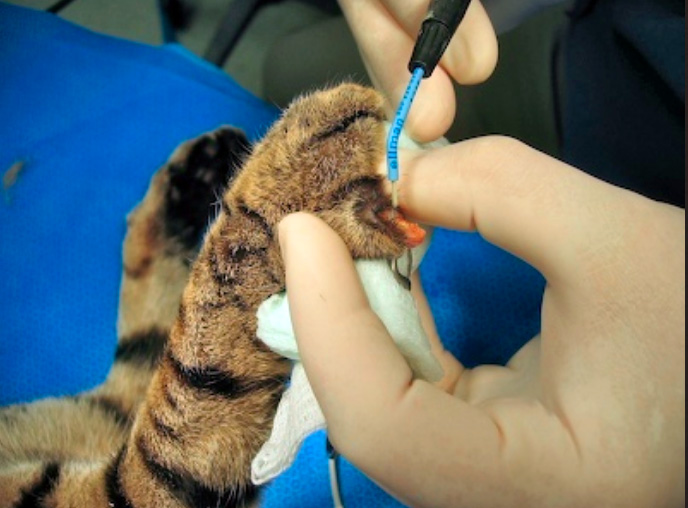Photo from the University of Georgia College of Veterinary Medicine website of an Ellman Radio surgery unit being used to declaw a cat.
Here’s another BIG veterinary convention that is offering many CE courses that help the health and well being of animals. Unfortunately there is also a course that basically promotes radiosurgery as a cost effective way to do surgeries and included in the list of procedures is amputating cat’s toe bones and claws. I will let this Dr Mayo explain it to you personally [button href=”http://www.jeffmayodvm.com/Pages/RadiosurgeryinSmallAnimals.aspx” color=”red” newwindow=”yes”] Radio surgery by Dr Mayo[/button]
While any new instrument may help reduce pain associated with surgery, it will do nothing for the lifetime pain and trauma inflicted through amputating 10 – 20 toes.
We need veterinarians to wake up, and truly evaluate what they are doing by declawing cats. How can any veterinarian argue that amputations don’t cause pain and especially how they can believe that amputating every toe on an animal does not cause it harm.
Where are their lectures on scratching behavior issues, behavior training, counseling cat owners about declawing etc.
There aren’t any because that does not make veterinarians money.
As most of you know, the most common procedure that is done with a laser in a veterinary practice is a declaw. The laser units cost around $30,000-$40,000 and these radio surgery units cost around $15,000. Many vets who declaw cats don’t want to spend that much money for a laser so here is an option that many will feel is more affordable. These pro-declaw vets will be able to falsely promote their radiosurgery technique for declaws as more humane than the old school ways like all of the laser declaw vets do.
Today, this CE “Hands-on course” at the CVC Convention in Kansas City, is being taught by a veterinarian who is an expert at this radio technology for veterinary medical procedures. This man is a master of using his Ellman radio surgery unit to perform all kinds of healing surgeries on animals yet he also uses it to perform the most inhumane, cruel, painful, and mutilating surgery in veterinary medicine with it. He is a great salesman for Ellman to promote this radio surgery technology for a procedure that is banned or considered unethical and never performed by veterinarians in most of the rest of the world.
It is just quite disturbing that “doctors” of veterinary medicine, who took an oath to heal and help animals would use their HANDS to willingly and purposely mutilate, harm, torture, and inhumanely maim a cat.
We all can only hope that someday the veterinary profession in North America will only have continuing education courses that are ONLY about healing animals and not about options and methods on how to mutilate their paws for the sake of a sofa or piece of furniture.
In fact it appears that Dr Mayo teaches this course to many veterinarians at the big conventions. This one was at the 2015 NAVC Conference.
One of my FBI (Feline Bureau of Investigation) members reached out the veterinary practice of this instructor, Dr Jeff Mayo, to find out how he personally addresses declawing since he is primarily an orthopedic doctor. As we all know, it’s important for any animal or human being to have a healthy paw or foot to walk on.
My FBI member posed the questions as a first time cat owner who wanted to get their 6 month old and 1 yr old cats declawed and the younger one neutered.
The nice licensed technician on the phone said that normally a cat neuter is $200-250 and with a declaw it would be an additional $150. The reason the declaw is cheaper than the usual price of $300-350, is because you are pairing it with a neuter. (Yep, it’s the usual package deal that veterinarians offer as a declaw with a neuter/spay.)
Is the vet is skilled at the declaws? The licensed technician said, “Dr Mayo been a doctor for 22 yrs so he’s been doing them (declaws) since he’s been out of school and not a lot of doctors do them (declaws) these days.”
Asked how the declaws are done. The nice vet tech on the phone said that they use radiosurgery for the declaws and said that it is “essentially the same thing as laser surgery and that it cauterizes the blood vessels as they are removing them, reduces swelling, bleeding, pain and is a lot faster and easier on the pet.” Once they are removed, they use a laser afterwards to reduce inflammation.
Is it inhumane to declaw my cats? “It is a controversial procedure because basically it’s like removing the top part of our fingertips. So it is controversial so it’s something that if you want to do it, you might see a little bit of behavioral issues afterwards, the cat might be aggressive, might be sensitive to the touch around the toes, so it’s really something that we recommend you look in to and make sure you really want to do before we go ahead and do it.” (Why is it that vets who declaw always seem to say that declawing is “controversial?” It’s not controversial, it is wrong, and inhumane, and cruel, and painful, and mutilating, and barbaric, and the list goes on. And if you asked any vet to declaw your dog because it was ruining your floors and if you couldn’t you would take it to a shelter, 99.9% of the time the vet would say they would never declaw a dog and to get help with a behaviorist for your dogs issues)
But you guys do them so it must not be inhumane? “Not necessarily, honestly, we all have our own opinions on it, so it’s really also dependent on the clients situation, if they are going to lose their apartment or house because their cat still has claws then of course we are going to say ok we don’t want you to lose your pet , we will do this but you need to know exactly what you are getting in to.”
Will my cat be ok afterwards? “We haven’t examined your cat but normally they do just fine afterwards.”
So there you have it. Radio surgery, laser surgery, guillotine method, or scalpel. They are ALL inhumane and mutilating methods of amputating the toe bones and claws from a cat’s paw.
Here is an AAHA hospital where the owner/veterinarian touts how great the Ellman radio unit is for declaws (and other surgeries) [button href=”http://www.sullyanimalhospital.com/declaw-in-cats.pml” color=”red” newwindow=”yes”] Loving Kind Compassionate Vet Declaw with Ellman Radio surgery unit[/button]
My FBI (Feline Bureau of Investigation) team reached out to this hospital as a first time cat owner for a declaw price. The owner/veterinarian actually spoke to them herself.
Dr Taddeo, said this, ” It (front declaw) usually ranges from $850- $950. That includes the procedure, staying two nights, pain meds, the blocks, paid meds to go home as well as and pre-op blood work. We use an electro surgical unit which is very similar to a laser. It cauterizes and helps with pain as well as cuts. The mechanism of how you use it is a little different than laser, lasers you have to wear googles and be a little more precautionary. I use both of them, but I like this one better. I also recommend a CRI for pain and local block of their paws. I just did two Birman cats two days ago and they recover very well and don’t have pain in their paws.”
Dr Taddeo was asked if it was humane and ok to declaw a cat and if the cats would be ok afterwards. She said, “A lot of vets don’t do them (declaws) anymore so we just do them very humanely and ok in regards to making sure they aren’t painful. Usually they are walking the next day after I do it.”
Asked if the cats will be ok and not limping or anything like that. Dr Taddeo said, “Nope, it’s just like any orthopedic surgery, 2 weeks is just probably the most critical care that they need, they shouldn’t be running, jumping, or playing because they could jump and ooze a bit so you have to confine them. They also have the lampshade ecollar on for 2 weeks but after those two weeks they’re fine, normal, happy go lucky.”
Asked if it’s on to declaw the 1 yr old and 2 1/2 yr old cat. “Dr Taddeo said, “Yes they are ok. The younger they are, the faster they heal so we recommend doing it soon rather than when they are 4 or 5.”
Asked about the horror stories about declawing online. ” There are a lot of veterinarians that don’t do it at all anymore. I still do it because a lot of times I feel that if the pet is either going to be put down or gets to have a home and be declawed, then I would rather have it declawed and do it properly and make sure they aren’t painful.”
“First time cat owner” said they just want to do it so their cats don’t scratch the furniture. Dr Taddeo said, “Right and some cats do have issues with scratching and some cats don’t at all. It just kind of depends on the pet.”
“First time cat owner” asked that if their cats are healthy then they can get the declaw done? Dr Taddeo said, “yes, you come in for the pre-op exam and then on that day we set up the day of the surgery.”
This doctor didn’t suggest humane alternative ideas, didn’t ask if the cats were currently scratching the furniture, and no counseling about the facts that declawing is an amputation procedure and has risks to the health and well being of the cat. (AAHA is strongly opposed to declawing and yet doesn’t enforce or care if their hospitals do it as a first option or as a last option. They don’t want to lose the $1070 or more in membershipdues from these member vets.)
Here is a link explaining the difference between laser and radio surgery and declawing is mentioned in this story. [button href=”http://www.veterinarypracticenews.com/May-2010/Beyond-Scalpels-Surgical-Substitutes/” color=”red” newwindow=”yes”] Beyond Scalpels [/button]
Here’s a vet practice that promotes their radio surgery units for declawing [button href=”http://bakerhousevets.com/radio-surgery-vs-laser-surgery/” color=”red” newwindow=”yes”] Radio surgery for declaws[/button]
Another veterinary practice info on laser/radio surgery declawing. (This one says the healing time for radio surgery is long than the old school methods. They also list the benefits of declawing as this. “Most kittens that are declawed correctly with adequate pain control before and after the procedure generally act like nothing ever happened the next day. Your furniture is safe, and there is nothing sweeter than a paw placed on your cheek with no fear of being scratched when your cat is being affectionate.” [button href=”http://www.allfelinehospital.com/declaws.pml” color=”red” newwindow=”yes”] All Feline Hospital Methods of declawing[/button]



